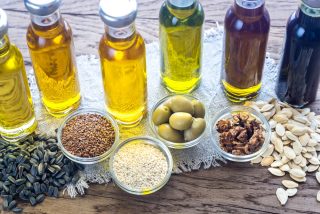When you’re grocery shopping for healthy cooking supplies, the oil aisle can feel overwhelming. So many varieties—is avocado better than grapeseed? Is olive healthier than sunflower?
Since oils are a calorie-rich fat, nutrition does matter. Most oils are high in “good” fats—polyunsaturated and monounsaturated. But some have higher amounts of “bad” fat—saturated. According to registered dietitians and cooking pros, nutritional facts are just one consideration when selecting a cooking oil. You should also make your oil choice based on smoke point, cooking method, taste and price.
An oil’s smoke point is the temperature at which the fat begins to break down and oxidize Why does smoke point matter? The higher smoke point oils are best for roasting, baking, frying or sautéing while those oils with lower smoke points make better dressings, sauces or dips.
Price differences may surprise you too, but cooking experts and foodies alike warn that pricier doesn’t always mean higher quality. Some oils, like avocado or peanut, are more expensive because they’re produced in smaller amounts: a simple case of supply and demand.
Now that you know what to look for, let’s break down the six most common cooking oils found in lighter cooking by what you should consider when shopping.
- Olive oil. Perhaps the most well-known, oil made from olives is widely available.

Smoke point – Ranges from about 325°F (extra-virgin olive oil) to about 465°F (extra-light olive oil). This means you’ll want to use extra-virgin varieties for a finishing oil or salad dressing and extra-light varieties for baking or high heat cooking.
Taste – Quality olive oil will taste like fresh olives with a bit of peppery bitterness.
Price – Since bottles can range from $8 to over $20, experts recommend choosing a dark bottle will help prevent rancidity from heat and light. You can also look for a seal of approval from organizations like the United States Department of Agriculture (USDA) or the North American Olive Oil Association (NAOOA).
Nutritional value – Just because extra-light olive oil is lighter in color doesn’t mean it’s lower in calories. The good news about olive oil: it’s rich in polyhpehnols, plant compounds linked to reducing the risk of cancer and heart diseases.
Recipe – For a quick salad dressing: whisk together ½ cup of olive oil with ¼ cup of balsamic vinegar, 1 tablespoon of Dijon mustard and 1 teaspoon of pure maple syrup.
- Vegetable oil. This is another familiar standby in most home kitchens—and also widely available and affordable. Vegetable oil is a blend of many different oils: from sunflower and peanut to canola, corn and soybean.
Smoke point – Ranges from 400 to 450°F making vegetable oil great for high heat oven cooking like baking or roasting.
Taste – You guessed it: vegetable oil tastes like veggies. Although, it’s not an overwhelming taste since vegetable oil is known for being very neutral in flavor.
Price – Extremely affordable, which is why you’ll find this variety in most kitchens. Save even more by purchasing a bulk package and use a smaller oil bottle for daily cooking needs.
Nutritional value – Vegetable oil in its purest form has the highest levels of polyunsaturated fats of any type of cooking oil. These types of fats are “good” and have been shown to lower coronary heart disease. But beware of partially hydrogenated vegetable oil that you’ll find in margarine, fried foods and packaged snacks since it has harmful trans fats, which are linked to heart disease.
Recipe – For an easy, nutritious and delicious dinner side: drizzle some fresh broccoli with vegetable oil and toss on a cookie sheet with sea salt and freshly ground pepper. Roast in an oven at 450°F for 20 minutes.
- Avocado oil. A more trendy option in recent years as avocados have also grown in popularity (after all, avocado toast and the avocado emoji are fan favorites).
Smoke point – Avocado oil has one of the highest smoke points at around 520°F, making it ideal if you plan to cook using really high heats.
Taste – Known for tasting more neutral than olive oil, avocado oil is slightly grassy with a very mild avocado flavor.
Price – Since avocado oil isn’t made as frequently as other oils, it can tend to be a bit more pricey. Nutritionists say the health benefits make it worth a small splurge.
Nutritional value – Considered a “heart-healthy” oil, it’s rich in monosaturated fats and has the potential to lower “bad” LDL cholesterol. But remember, you won’t get all the benefits of eating an actual avocado just by using the oil.
Recipe – Combine real avocados with the oil with this delicious recipe for baked tortilla chips with grilled fig salsa.
- Peanut oil. Also trending and another high heat oil, this one is popular in Asian cuisine.
Smoke point – About 450°F, another high heat option.
Taste – Slight nuttiness in flavor lends itself well to Asian foods and comfort dishes like chicken and potatoes.
Price – Just like avocado oil, peanut oil has a higher cost than a standard vegetable or canola oil.
Nutritional value – Peanut oil is high in monounsaturated fat and has phytosterols that can help keep your cholesterol in check. If you have a peanut allergy, you’ll be glad to know you can eat peanut oil as long as it’s not cold-pressed since proteins in peanuts that cause allergic reactions are removed when refined into an oil. One concern: peanut oil is rich in inflammatory omega-6. Moderate amounts of this fatty acid are ok, but too much is not good. One option is to use peanut oil combined with other omega-3 rich oils, like olive oil.
Recipe – This vegetable peanut stir fry is easy to make and beautiful to look at. Plus, it’ll get you a large serving of vegetables that taste delicious cooked in peanut oil.
- Grapeseed oil. Made from the seeds of grapes, not grapes themselves. Fun fact: grape seeds are normally discarded in the wine making process.
Smoke point – About 420°F, relatively high smoke point and great for baking.
Taste – Clean taste makes it an ideal “all-purpose” oil to have on hand. If you’re looking for more flavor, infuse with chili, rosemary or citrus.
Price – Because it’s created as a by-product of winemaking, grapeseed oil is available in high yields and is usually fairly expensive.
Nutritional value – Rich in omega-6 fatty acids, can be used to substitute butter, margarine or shortening to reduce inflammation. Remember to eat grapeseed oil in moderation since too much omega-6 is not good for you. Counteract too much omega-6 with omega-3 foods like fatty fish and nuts.
Recipe – Make this delicious, lighter version of raspberry vinaigrette dressing using grapeseed oil and for an appetizer that’s easy and yummy, drizzle it over melon wedges (or fresh figs) draped with thin slices of prosciutto.
- Sunflower seed oil. Yes, this option is made from tiny sunflower seeds.
Smoke point – About 450°F, recommended for sautéing, stir frying and baking.
Taste – Slightly nutty flavor.
Price – Pricier than standard oils, you can save by buying a store or generic brand of this variety.
Nutritional value – With many varieties, some are higher in monounsaturated fats than others. Substituting sunflower oil for saturated fats in your diet can help with cholesterol. Plus, it’s high in Vitamin E, which helps your skin stay healthy.
Recipe – Cook up these delicious Shishito Peppers on your stovetop for some healthy spice—and if you don’t have sunflower oil on hand, you can sub avocado oil.
Remember that with any food item, portion sizes matter to keep fat and calories at healthy levels. A standard serving size of oil is 1 tablespoon. Use 2-3 tablespoons for feeding a family of four. And remember if you’re baking, you can lighten any sweet recipe by cutting oil in half and replacing the other half with pureed fruit like mashed banana, pureed pears or sugar-free applesauce.


